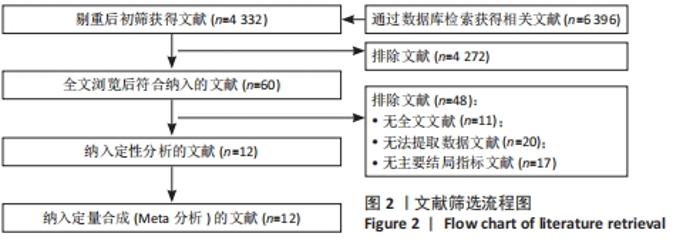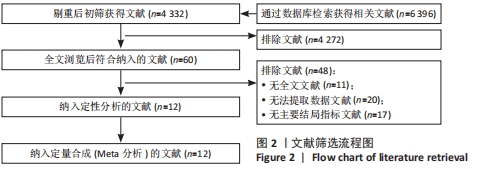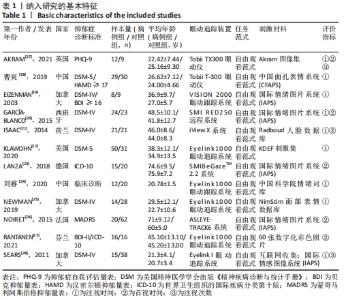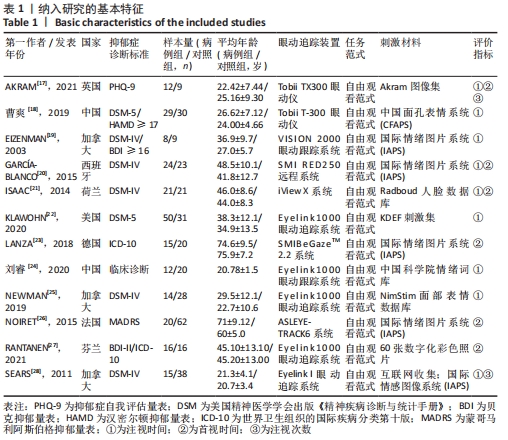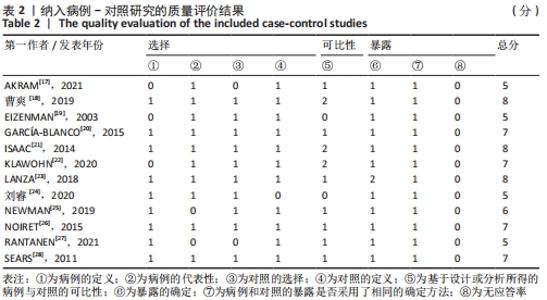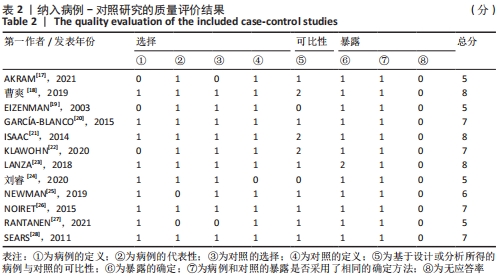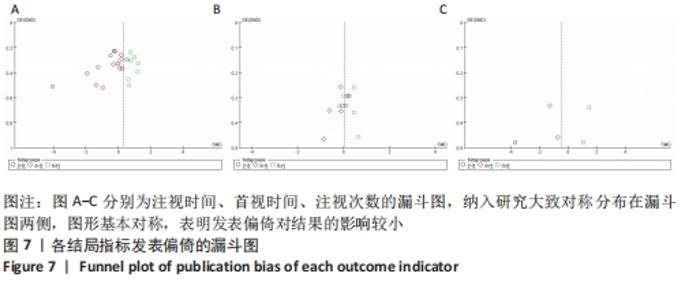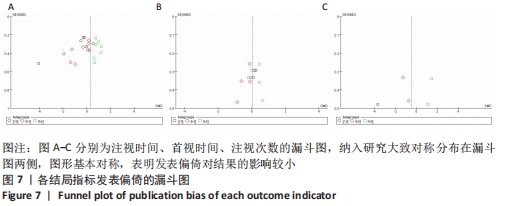Chinese Journal of Tissue Engineering Research ›› 2022, Vol. 26 ›› Issue (29): 4735-4741.doi: 10.12307/2022.836
Previous Articles Next Articles
Gaze characteristics of emotional faces in depressed patients: a Meta-analysis based on eye movement studies
Xia Haisha1, Li Yuxi2, Liu Xiaobo1, Fan Jin1, Zhang Jiaming1, Gou Xinyun1, Li Juan1, Zheng Zhong3, Jin Rongjiang1
- 1School of Health Cultivation and Rehabilitation, 2School of Acupuncture, Moxibustion and Tuina, Chengdu University of Traditional Chinese Medicine, Chengdu 610075, Sichuan Province, China; 3West China Hospital, Sichuan University, Chengdu 610044, Sichuan Province, China
-
Received:2021-11-11Accepted:2021-12-04Online:2022-10-18Published:2022-03-28 -
Contact:Jin Rongjiang, MD, Professor, Doctoral supervisor, School of Health Cultivation and Rehabilitation, Chengdu University of Traditional Chinese Medicine, Chengdu 610075, Sichuan Province, China -
About author:Xia Haisha, Master candidate, School of Health Cultivation and Rehabilitation, Chengdu University of Traditional Chinese Medicine, Chengdu 610075, Sichuan Province, China -
Supported by:the National Natural Science Foundation of China, No. 81873354 (to ZZ); Sichuan Provincial Science and Technology Plan, No. 2020YFS0284 (to ZZ); the National Key Research and Development Program of China, No. 2019YFC1710302 (to JRJ)
CLC Number:
Cite this article
Xia Haisha, Li Yuxi, Liu Xiaobo, Fan Jin, Zhang Jiaming, Gou Xinyun, Li Juan, Zheng Zhong, Jin Rongjiang. Gaze characteristics of emotional faces in depressed patients: a Meta-analysis based on eye movement studies[J]. Chinese Journal of Tissue Engineering Research, 2022, 26(29): 4735-4741.
share this article
Add to citation manager EndNote|Reference Manager|ProCite|BibTeX|RefWorks
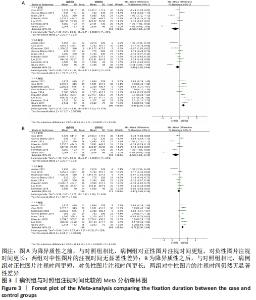
2.3 Meta分析结果 2.3.1 各组注视时间的差异 (1)正性情绪图片:共纳入7项研究[18,20-22,24-25,28]。由于研究间异质性较大(I2=93%),故采用随机效应模型进行Meta分析,结果显示,病例组比对照组对正性情绪图片注视时间更短(SMD=-1.00,95%CI:-1.88至-0.12,P=0.03)。多次反复查验数据后,异质性来源仍较难解释,考虑为在研究对象的确定、无关变量的控制及研究工具的选择和使用上存在较大异质性,但大多数健康受试者均表现出明显的正性刺激偏向,不影响总体判断。 (2)中性情绪图片:共纳入9项研究[17-22,24-25,28],包括180例患者和209例对照。由于研究间异质性较大(I2=81%),故采用随机效应模型进行Meta分析,结果显示,病例组和对照组对中性情绪图片的注视时间的差异无显著性意义(SMD=-0.45,95%CI:-0.95-0.04,P=0.07),见图3A。排除Sears等[28]的研究后异质性明显降低(I2=45%),提示其为异质性来源。对其他研究汇总,因部分亚组内具有统计学异质性,故采用随机效应模型进行Meta分析,结果仍然显示差异无有显著性意义(SMD=-0.17,95%CI:-0.48-0.14,P=0.28),见图3B。"
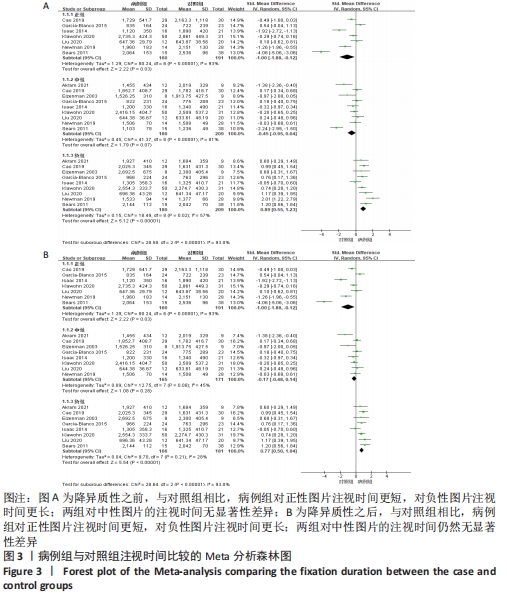
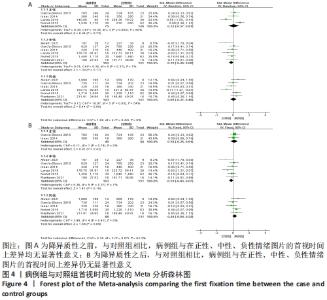
(3)负性情绪图片:共纳入9项研究[17-22,24-25,28],包括180例患者和209例对照。由于研究间有异质性(I2=57%),故采用随机效应模型进行Meta分析,结果显示,病例组比对照组对负性情绪图片注视时间更长(SMD=0.89,95%CI:0.55-1.23,P < 0.000 01),见图3A。排除NEWMAN等[25]的研究后,研究异质性显著降低(I2=28%),提示其为异质性来源。对其他研究汇总,因部分亚组内具有统计学异质性,故采用随机效应模型进行Meta分析,结果仍然显示病例组比对照组对负性情绪图片注视时间更长(SMD=0.77,95%CI:0.50-1.04,P < 0.000 01),见图3B。 2.3.2 首视时间 (1)正性情绪图片:共纳入4项研究[20-21,23,26]。由于研究间异质性较大(I2=80%),故采用随机效应模型进行Meta分析,结果显示,病例组和对照组首视时间的差异无显著性意义(SMD=0.12,95%CI:-0.57-0.81,P=0.73),见图4A。排除LANZA等[23]及NOIRET等[26]的研究后异质性消失(I2=0%),提示其为异质性来源。对其他研究汇总并采用固定效应模型进行Meta分析,结果仍然显示差异无显著性意义(SMD=0.18,95%CI:-0.25-0.61,P=0.42),见图4B。"
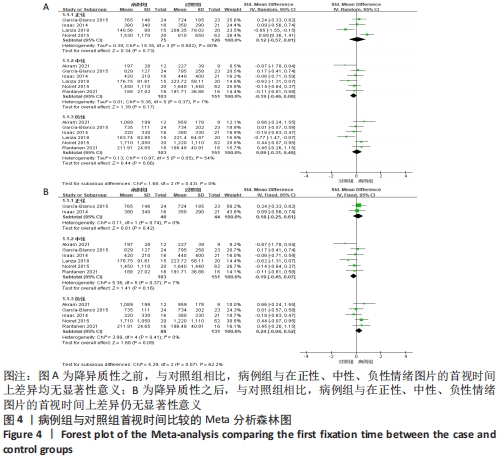
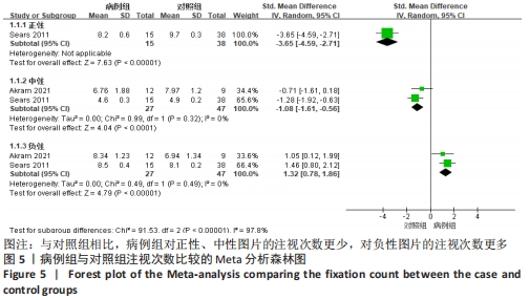
(2)中性情绪图片:共纳入6项研究[17,20-21,23,26-27]。研究间异质性较小(I2=7%),但因部分亚组内具有统计学异质性,故采用随机效应模型进行Meta分析,结果显示,两组首视时间的差异无显著性意义(SMD=-0.19,95%CI:-0.46-0.08,P=0.17),见图4A。排除亚组内高异质性文献,采用固定效应模型进行 Meta分析,结果仍然显示,两组首视时间的差异无显著性意义(SMD=-0.19,95%CI:-0.45-0.07,P=0.16),见图4B。 (3)负性情绪图片:共纳入6项研究[17,20-21,23,26-27]。由于研究间异质性较大(I2=54%),故采用随机效应模型进行Meta分析,结果显示,病例组和对照组首视时间的差异无显著性意义(SMD=0.09,95%CI:-0.31-0.48,P=0.66),见图4A。排除LANZA等[23]的研究后异质性消失(I2=0%),提示其为异质性来源。对其他研究汇总并采用固定效应模型进行Meta分析,结果仍然显示差异不具有显著性意义(SMD=0.24,95%CI:-0.04-0.52,P=0.09),见图4B。 2.3.3 注视次数 (1)正性情绪图片:仅有1项研究报道了两组对正性情绪图片的注视次数[28],通过对比发现病例组比对照组对正性情绪图片的注视次数更少(SMD=-3.65,95%CI:-4.59至-2.71,P < 0.000 01),见图5。"
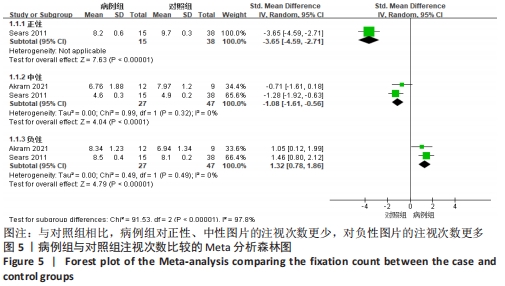
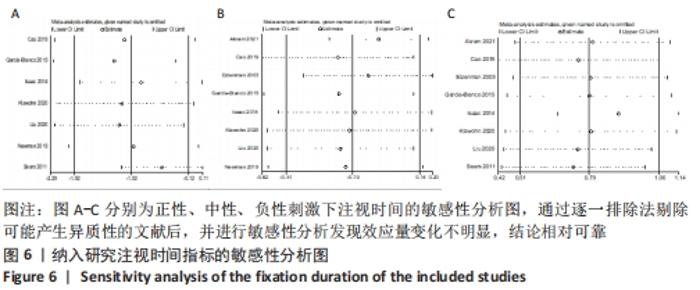
(2)中性情绪图片:共纳入2项研究[17,28]。由于研究间无异质性(I2=0%),故采用固定效应模型进行Meta分析,结果显示,病例组比对照组对中性情绪图片的注视次数更多(SMD=-1.08,95%CI:-1.61至-0.56,P < 0.000 1),见图5。 (3)负性情绪图片:共纳入2项研究[17,28]。由于研究间无异质性(I2=0%),故采用固定效应模型进行Meta分析,结果显示,病例组比对照组对负性情绪图片的注视次数更多(SMD=1.32,95%CI:0.78-1.86,P < 0.000 01),见图5。 2.4 敏感性分析结果 通过逐一剔除纳入研究,进行敏感性分析。在对正性图片注视时间的观察中,见图6A,排除ISAAC等[21]、NEWMAN等[25]及SEARS等[28]3篇文献后,SMD分别变为-0.85(95%CI:-1.79-0.09)、-0.96(95%CI:-1.97-0.05)、-0.52(95%CI:-1.15-0.10),提示正性图片注视时间的结果不稳定。"
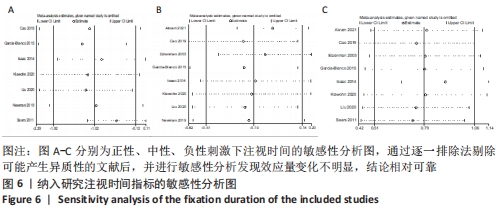
| [1] KORGAONKAR MS, GOLDSTEIN-PIEKARSKI AN, FORNITO A, et al. Intrinsic connectomes are a predictive biomarker of remission in major depressive disorder. Mol Psychiatry. 2020;25(7):1537-1549. [2] FRIEDRICH MJ. Depression is the leading cause of disability around the world. JAMA. 2017;317(15):1517. [3] 李则宣.抑郁症的表观遗传学机制:涉及认知灵活性的证据[J].济宁医学院学报, 2017,40(5):361-365. [4] TAYLOR JL, JOHN CH. Attentional and memory bias in persecutory delusions and depression. Psychopathology. 2004;37(5): 233-241. [5] PARSONS S. Does attention bias modification induce structural brain changes? A commentary on Abend et al. (2019). Biol Psychol. 2020;152:107866. [6] KOSTER EH, DE LISSNYDER E, DERAKSHAN N, et al. Understanding depressive rumination from a cognitive science perspective: the impaired disengagement hypothesis. Clin Psychol Rev. 2011;31(1):138-145. [7] PARRA MA, SáNCHEZ MG, VALENCIA S, et al. Attentional bias during emotional processing: evidence from an emotional flanker task using IAPS. Cogn Emot. 2018; 32(2):275-285. [8] PRICE RB, DUMAN R. Neuroplasticity in cognitive and psychological mechanisms of depression: an integrative model. Mol Psychiatry. 2020;25(3):530-543. [9] RAYNER K. Eye movements in reading and information processing. Psychol Bull. 1978;85(3):618-660. [10] ASHRAF H, SODERGREN MH, MERALI N, et al. Eye-tracking technology in medical education: a systematic review. Med Teach. 2018;40(1):62-69. [11] 徐阿娜.眼动检测仪辅助诊断精神分裂症的临床效果及可行性分析[J].中国医疗器械信息,2021,27(18):164-165. [12] STOLICYN A, STEELE JD, SERIèS P. Prediction of depression symptoms in individual subjects with face and eye movement tracking. Psychol Med. 2020;9:1-9. [13] ECKSTEIN MK, GUERRA-CARRILLO B, MILLER SINGLEY AT, et al. Beyond eye gaze: what else can eyetracking reveal about cognition and cognitive development? Dev Cogn Neurosci. 2017;25:69-91. [14] ARMSTRONG T, OLATUNJI BO. Eye tracking of attention in the affective disorders: a meta-analytic review and synthesis. Clin Psychol Rev. 2012;32(8):704-723. [15] SUSLOW T, HUßLACK A, KERSTING A, et al. Attentional biases to emotional information in clinical depression: a systematic and meta-analytic review of eye tracking findings. J Affect Disord. 2020;274:632-642. [16] Wells G. The Newcastle-Ottawa Scale (NOS) for Assessing the Quality of Non-Randomised Studies in Meta-Analyses// Symposium on Systematic Reviews: Beyond the Basics. 2014. [17] AKRAM U, ELLIS JG, CAU G, et al. Eye tracking and attentional bias for depressive internet memes in depression. Exp Brain Res. 2021;239(2):575-581. [18] 曹爽,吴迪,邢辰,等.抑郁症患者面孔识别注意偏向的时间进程研究[J].中华行为医学与脑科学杂志,2019,28(12):1075-1080. [19] EIZENMAN M, YU LH, GRUPP L, et al. A naturalistic visual scanning approach to assess selective attention in major depressive disorder. Psychiatry Res. 2003; 118(2):117-128. [20] GARCíA-BLANCO A, SALMERóN L, PEREA M. Attentional capture by emotional scenes across episodes in bipolar disorder: evidence from a free-viewing task. Biol Psychol. 2015;108:36-42. [21] ISAAC L, VRIJSEN JN, RINCK M, et al. Shorter gaze duration for happy faces in current but not remitted depression: evidence from eye movements. Psychiatry Res. 2014;218(1-2): 79-86. [22] KLAWOHN J, BRUCHNAK A, BURANI K, et al. Aberrant attentional bias to sad faces in depression and the role of stressful life events: evidence from an eye-tracking paradigm. Behav Res Ther. 2020;135:103762. [23] LANZA C, MüLLER C, RIEPE MW. Positive mood on negative self-statements: paradoxical intervention in geriatric patients with major depressive disorder. Aging Ment Health. 2018;22(6):748-754. [24] 刘睿.基于眼动指标的抑郁评估模型研究[D].成都:西南交通大学,2020. [25] NEWMAN K, QUIGLEY L, FERNANDEZ A, et al. Concurrent and prospective relations between attentional biases for emotional images and relapse to depression. Cogn Ther Res. 2019;43(5):893-909. [26] NOIRET N, CARVALHO N, LAURENT É, et al. Visual scanning behavior during processing of emotional faces in older adults with major depression. Aging Ment Health. 2015; 19(3):264-273. [27] RANTANEN M, HAUTALA J, LOBERG O, et al. Attentional bias towards interpersonal aggression in depression - an eye movement study. Scand J Psychol. 2021;62(5):639-647. [28] SEARS CR, NEWMAN KR, FERENCE JD, et al. Attention to emotional images in previously depressed individuals: an eye-tracking study. Cogn Ther Res. 2011;35(6):517-528. [29] BEEVERS CG, CLASEN PC, ENOCK PM, et al. Attention bias modification for major depressive disorder: effects on attention bias, resting state connectivity, and symptom change. J Abnorm Psychol. 2015;124(3):463-475. [30] WOOLRIDGE SM, HARRISON GW, BEST MW, et al. Attention bias modification in depression: a randomized trial using a novel, reward-based, eye-tracking approach. J Behav Ther Exp Psychiatry. 2021;71:101621. [31] YANG W, ZHANG JX, DING Z, et al. Attention bias modification treatment for adolescents with major depression: a randomized controlled trial. J Am Acad Child Adolesc Psychiatry. 2016;55(3):208-218. [32] HERMANS D, VANSTEENWEGEN D, EELEN P. Eye movement registration as a continuous index of attention deployment: data from a group of spider anxious students. Cogn Emotion. 1999;13(4):419-434. [33] NIEHORSTER DC, ZEMBLYS R, BEELDERS T, et al. Characterizing gaze position signals and synthesizing noise during fixations in eye-tracking data. Behav Res Methods. 2020;52(6):2515-2534. [34] 姜婷婷,吴茜,徐亚苹,等.眼动追踪技术在国外信息行为研究中的应用[J].情报学报,2020,39(2):217-230. [35] 闫志明,郭喜莲,王睿.多媒体学习研究中眼动指标述评[J].现代教育技术,2018, 28(5):33-39. [36] 孙文芳,王馨悦,王长生,等.专家运动员的视觉搜索特征:基于眼动研究的Meta分析[J].天津体育学院学报,2018, 33(4):321-328. [37] FOLAND-ROSS LC, GOTLIB IH. Cognitive and neural aspects of information processing in major depressive disorder: an integrative perspective. Front Psychol. 2012;3:489. [38] LAZAROV A, BEN-ZION Z, SHAMAI D, et al. Free viewing of sad and happy faces in depression: a potential target for attention bias modification. J Affect Disord. 2018;238: 94-100. [39] DUQUE A, VáZQUEZ C. Double attention bias for positive and negative emotional faces in clinical depression: evidence from an eye-tracking study. J Behav Ther Exp Psychiatry. 2015;46:107-114. [40] ZHANG G, YUAN B, HUA H, et al. Individual differences in first-pass fixation duration in reading are related to resting-state functional connectivity. Brain Lang. 2021; 213:104893. [41] 徐西良.复发性抑郁缓解期个体注意偏向的眼动及认知干预实验研究[D].南昌:江西师范大学,2013. [42] 范亮亮.首发抑郁障碍患者情绪面孔注意偏向的眼动研究[D].新乡:新乡医学院,2017. [43] WERMES R, LINCOLN TM, HELBIG-LANG S. How well can we measure visual attention? psychometric properties of manual response times and first fixation latencies in a visual search paradigm. Cogn Ther Res. 2017;41(4):588-599. [44] SKINNER IW, HüBSCHER M, MOSELEY GL, et al. The reliability of eyetracking to assess attentional bias to threatening words in healthy individuals. Behav Res Methods. 2018;50(5):1778-1792. [45] 任翰林,黄亮,郑玉玮,等.自闭症谱系障碍儿童的肢体情绪加工特征:来自眼动的证据[J].中国临床心理学杂志, 2021,29(1):8-13. |
| [1] | Jing Jinpeng, Zhang Yue, Liu Xiaomin, Liu Yi. Traditional Chinese medicine injection for promoting blood circulation in prevention of deep vein thrombosis after orthopedic surgery: network meta-analysis [J]. Chinese Journal of Tissue Engineering Research, 2022, 26(9): 1467-1476. |
| [2] | Tang Wenjing, Wu Siyuan, Yang Chen, Tao Xi. Inflammatory responses in post-stroke depression [J]. Chinese Journal of Tissue Engineering Research, 2022, 26(8): 1278-1285. |
| [3] | Liu Gang, Ma Chao, Wang Le, Zeng Jie, Jiao Yong, Zhao Yi, Ren Jingpei, Hu Chuanyu, Xu Lin, Mu Xiaohong. Ankle-foot orthoses improve motor function of children with cerebral palsy: a Meta-analysis based on 12 randomized controlled trials [J]. Chinese Journal of Tissue Engineering Research, 2022, 26(8): 1299-1304. |
| [4] | Li Yuqiao, Sun Tianwei, Ma Bin, Zhou Zhaohong, Dong Runbei, Wu Haiyang. A comparative study of imaging parameters and quality of life scores between subtypes of lumbar spondylolisthesis [J]. Chinese Journal of Tissue Engineering Research, 2022, 26(6): 943-948. |
| [5] | Liu Yiyi, Qiu Junqiang, Yi Longyan, Zhou Cailiang. Effect of resistance training on interleukin-6 and C-reactive protein in middle-age and elderly people: a Meta-analysis [J]. Chinese Journal of Tissue Engineering Research, 2022, 26(5): 804-812. |
| [6] | Wang Nan, Qian Yuzhang, Xie Lin. Network Meta-analysis of different acupuncture methods for the treatment of lumbar disc herniation [J]. Chinese Journal of Tissue Engineering Research, 2022, 26(5): 813-820. |
| [7] | Wei Zhoudan, Li Wenjin, Zhu Li, Wang Yu, Zhao Jiaoyang, Chen Yanan, Guo Dong, Hao Min. Platelet-rich fibrin as a material for alveolar ridge preservation significantly reduces the resorption of alveolar bone height and width after tooth extraction: a meta-analysis [J]. Chinese Journal of Tissue Engineering Research, 2022, 26(4): 643-648. |
| [8] | Ou Liang, Kong Dezhong, Xu Daoqing, Ni Jing, Fu Xingqian, Huang Weichen. Comparative clinical efficacy of polymethyl methacrylate and self-solidifying calcium phosphate cement in vertebroplasty: a meta-analysis [J]. Chinese Journal of Tissue Engineering Research, 2022, 26(4): 649-656. |
| [9] | Yang Ruijia, Jiang Lingkai, Dong Zhengquan, Wang Yunfei, Ma Zhou, Cong Linlin, Guo Yanjing, Gao Yangyang, Li Pengcui. Open reduction and internal fixation versus circular external fixation for tibial plateau fractures: a meta-analysis [J]. Chinese Journal of Tissue Engineering Research, 2022, 26(3): 480-486. |
| [10] | Zhong Yuanming, He Bingkun, Wu Zhuotan, Wu Sixian, Wan Tong, Zhong Xifeng. Meta-analysis of efficacy and safety of Jack kyphoplasty for osteoporotic vertebral compression fractures [J]. Chinese Journal of Tissue Engineering Research, 2022, 26(3): 487-492. |
| [11] | Zhang Tiantian, Li Jiamin, Ou Liang, Shang Yan, Xu Yaqian, Hu Guoheng. Electromyographic biofeedback for post-stroke limb spasticity: a Meta-analysis [J]. Chinese Journal of Tissue Engineering Research, 2022, 26(29): 4742-4748. |
| [12] | Zheng Wei, Sun Libing, Xiong Yingzhe, Zhang Yichi, You Jing, Huang Wenqi, Guo Yanhua, Liu Hongjun. Effect of eccentric strengthening on hamstring strength: a Meta-analysis [J]. Chinese Journal of Tissue Engineering Research, 2022, 26(29): 4749-4756. |
| [13] | Qiao Qiqi, Wu Yixin, Wang Xin, Xia Zhongliang. Effect of high-definition transcranial direct current stimulation on human dynamic balance [J]. Chinese Journal of Tissue Engineering Research, 2022, 26(26): 4192-4198. |
| [14] | Li Gaofeng, Wang Jun. Effects of concurrent aerobic and strength training on locomotor performance: a Meta-analysis [J]. Chinese Journal of Tissue Engineering Research, 2022, 26(26): 4258-4264. |
| [15] | Zhao Shuying, Guo Guangling, Liu Chenchen, Zhang Chao, Dong Sirui, Gong Qinqin, Ji Luwei. Stem cell transplantation in the treatment of premature ovarian failure: a meta-analysis based on 13 animal studies [J]. Chinese Journal of Tissue Engineering Research, 2022, 26(25): 4084-4092. |
| Viewed | ||||||
|
Full text |
|
|||||
|
Abstract |
|
|||||
